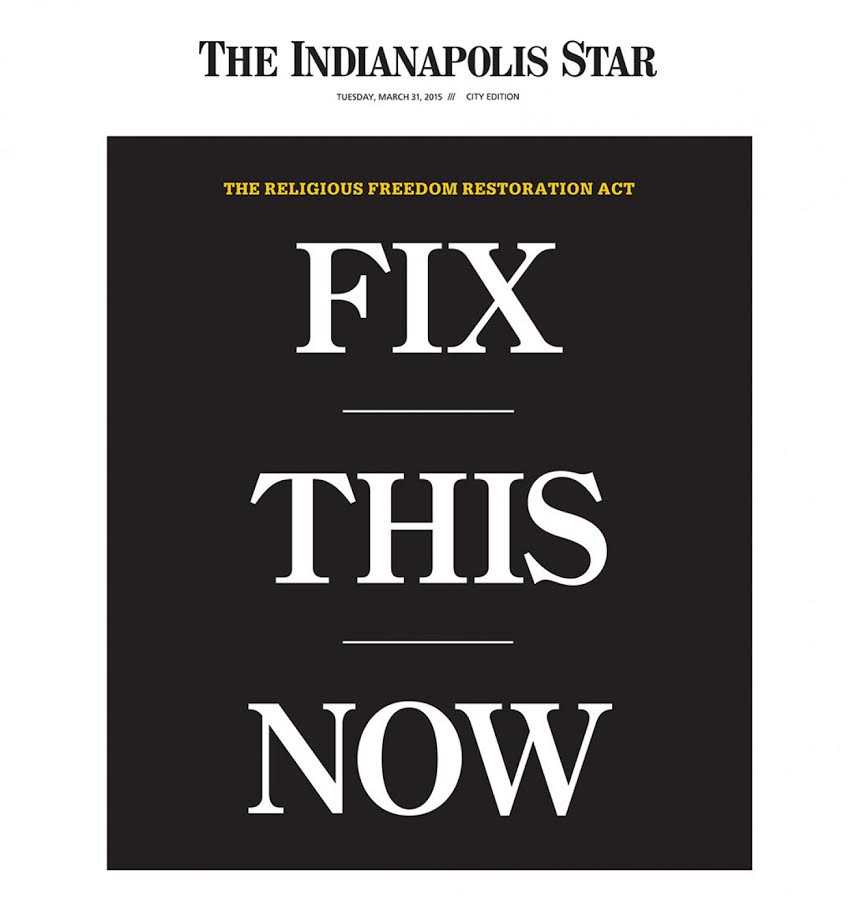A Problem in Need of Fixing: Indiana, LGBT, and Religious Freedom
On March 31, the front page of the Indianapolis Star, the largest newspaper in the state of Indiana, looked a little different than usual. In a move nearly unheard of in mainstream print journalism, the Star placed an editorial on its first page with a large and bold graphic stating plainly “FIX THIS NOW.” What issue or event caused such a stir amongst the public and media to demand this type of attention? The answer: Indiana’s passage of the Religious Freedom Restoration Act, or RFRA for short.
Almost immediately after Governor Mike Pence approved the law, it attracted significant attention and generated widespread controversy due to its intersection of religion, discrimination, gay and transgender rights, and politics. Observers noted that the law seemingly would allow discrimination against members of the LGBT community, for no other apparent reason apart from their sexuality or gender identities. Defenders argued that many states have similar laws on the books and that the Indiana law was crafted closely after the national RFRA that was passed in the 1990s. The media maelstrom set into motion by the law is first and foremost evidence of the progress made by the gay rights movement in the eyes of the public in the last two decades, a sea change in social attitudes that cannot be understated. After over a week of intense scrutiny and backlash, the governor and Indiana’s legislature relented, amending the bill with a set of specific protections for LGBT individuals. Politically, this was about the best that Pence and company could achieve, as the amendments undoubtedly improved the most problematic aspects of the law while avoiding completely losing face among conservative supporters of the law who comprise a key voting bloc of the Republicans’ support base in the state.
To say that the issue at hand is more complicated than either supporters or opponents of the law will readily acknowledge is not to say that the situation did not need immediate action; it did, and though the public backlash was in many ways unprecedented, it was also justified. It is not morally or legally acceptable to allow discrimination against an entire class of human beings. If the law, as some commentators have argued, could have possibly allowed for this type of discrimination as it was originally written, then we can say the added gay rights protections were sorely needed. Admittedly, that is different from forcing organizations or individuals to perform services that they may consider immoral.
To oversimplify, the distinction can be illustrated by two scenarios: a baker refusing to make a cake for a customer just because the customer happens to be gay and a baker refusing to make a cake for a customer because it will be used in same sex wedding ceremony. The former is always and unequivocally wrong, but the latter hypothetical, while we may still disagree strongly with the baker’s viewpoint, raises difficult and troubling questions about the extent to which government or society can make an individual act in personally immoral ways.
When considering the dynamic between issues of religion and sexuality, it’s critical to keep in mind “where we are,” so to speak, in regard to these subjects. Gay and transgender individuals still face horrendous treatment and conditions throughout the world, and although our own country has made considerable progress in recent years, bigotry still exists in the United States. Although it’s clear that tables are turning, progressives committed to an open society should still be wary of overreach. The case of the web browser Mozilla’s Brandon Eich, who was removed from CEO on the basis of his anti-gay beliefs, and the strong corporate response to the Indiana law are clear bellwethers that Big Business now strongly supports gay rights. The right to practice one’s religion is still an important and necessary liberty even in an increasingly secular society and world, and in many ways religious freedom is a key foundation to the entire creation of the United States itself as a country. Laws protecting these liberties are the same as laws that enshrine any other right in law; they exist not to protect the strong but to protect the weak because the majority opinion is never one that needs legal protection. Consider the case that was the impetus for the original, federal RFRA: Employment Division v. Smith. This monumental case, which was decided by the U.S. Supreme Court in 1990, protected a Native American tribe’s use of an otherwise illegal psychoactive substance in religious ceremonies. Religious groups can also be marginalized and oppressed, especially if they are small and lack access to traditional channels of power.
Put simply, there is no need to choose between protecting LGBT rights and protecting religious groups. If the situations are examined carefully and thoughtfully, then there need not be any contradiction between the two. If the United States truly is the “land of the free” that it proclaims itself to be, then surely we as a nation can balance the rights of individuals in a way that is fair and equitable for all.


